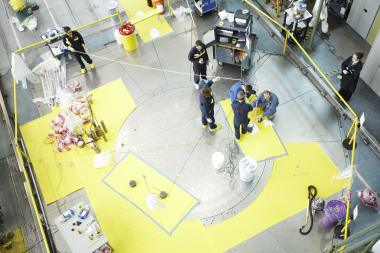The world's top reactor for producing medical isotopes is likely to be out of action until the end of the year, while major repairs to the next-biggest producer are scheduled soon after that.
 |
| NRU inspections last month |
Having examined eight of the nine vulnerable areas and determined that at least three repairs are required, Atomic Energy of Canada Ltd (AECL) announced today that "it is now clear that the NRU will not return to service before late 2009."
The decision to make the announcement was made last week, AECL executives told a press conference, explaining that work to design a repair tool was underway, but that the specification of the device was still evolving. Even after design is complete and the tool is made, several tests would be required on a mock-up before any attempts would be made to actually repair the NRU. The repair process itself will obviously take a certain amount of time, as will tests to determine the quality of the work.
After repair, the process to restart NRU would begin - itself a major project requiring the vessel the be refilled with heavy water and fuel to be put back in the core. After start-up the reactor would take about one week to reach full power and another week would pass before the first shipments of medical radioisotopes.
In the meantime, production reactors in Europe and South Africa have coordinated their refuelling and maintenance schedules to give maximum availability and medical centres worldwide have been able to cope.
However, the second most prolific producer of isotopes, the HFR at Petten in the Netherlands is also in need of repair. It also has a minor leak, with tiny bubbles of gas passing from a pipe wall into the primary cooling system, but this will be difficult to repair as it is from a pipe underneath the reactor which is encased in concrete which also forms part of the biological shield. The reactor's operator, NRG, has an extraordinary licence to run the reactor in its current interim state until March 2010, but then must make the major repair. A plan for the work will be submitted to authorities in the second half of this year.




_47120.jpg)
_23621.jpg)

_63865.jpg)





